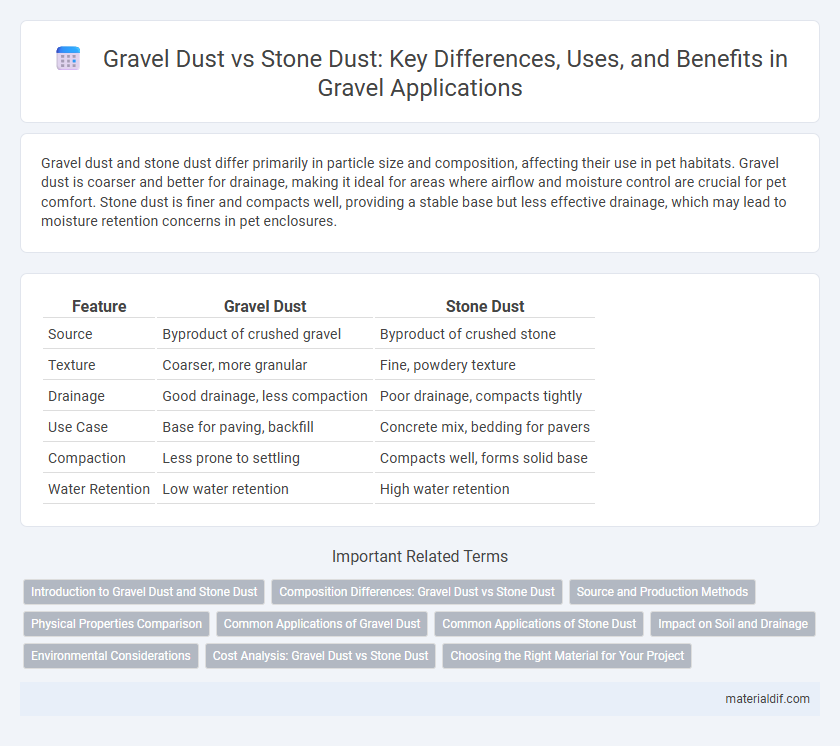Gravel dust and stone dust differ primarily in particle size and composition, affecting their use in pet habitats. Gravel dust is coarser and better for drainage, making it ideal for areas where airflow and moisture control are crucial for pet comfort. Stone dust is finer and compacts well, providing a stable base but less effective drainage, which may lead to moisture retention concerns in pet enclosures.
Table of Comparison
| Feature | Gravel Dust | Stone Dust |
|---|---|---|
| Source | Byproduct of crushed gravel | Byproduct of crushed stone |
| Texture | Coarser, more granular | Fine, powdery texture |
| Drainage | Good drainage, less compaction | Poor drainage, compacts tightly |
| Use Case | Base for paving, backfill | Concrete mix, bedding for pavers |
| Compaction | Less prone to settling | Compacts well, forms solid base |
| Water Retention | Low water retention | High water retention |
Introduction to Gravel Dust and Stone Dust
Gravel dust consists of fine particles produced during the crushing and grinding of gravel, commonly used as a stabilizing base material in construction and landscaping projects. Stone dust, also known as crusher dust, is finer and denser, derived from crushed stone and optimal for creating strong, compacted surfaces. Both materials serve distinct purposes in road base layers, concrete mixes, and paving foundations due to their unique particle size and compaction properties.
Composition Differences: Gravel Dust vs Stone Dust
Gravel dust is primarily composed of naturally weathered rock particles, often containing a mix of various minerals and organic materials, whereas stone dust consists mainly of finely crushed quarried stone, typically granite or limestone, with a more uniform mineral composition. Gravel dust particles tend to be coarser and less consistent in size compared to the finer, more homogenous texture of stone dust. The mineralogical differences affect their binding properties, drainage capabilities, and suitability for construction or landscaping applications.
Source and Production Methods
Gravel dust originates from the natural erosion and crushing of riverbed gravel, characterized by its rounded particles and varied mineral composition. Stone dust is produced through the mechanical crushing of hard rocks such as granite or limestone, resulting in fine, angular particles with consistent mineral properties. The production methods impact the texture and suitability of each dust for construction and landscaping applications.
Physical Properties Comparison
Gravel dust has coarser particles and better drainage properties, making it ideal for concrete mixing and road construction, while stone dust consists of finer particles that compact densely and retain moisture, enhancing stability in paving applications. The particle size distribution of gravel dust ranges from 4.75 mm to 0.075 mm, whereas stone dust particles are mostly below 0.075 mm, contributing to their different compaction and permeability characteristics. Understanding these physical differences helps optimize material selection based on load-bearing capacity and drainage requirements in construction projects.
Common Applications of Gravel Dust
Gravel dust, a fine material derived from weathered gravel, is commonly used as a base layer for paving, road construction, and concrete production due to its excellent compaction properties and drainage capabilities. Unlike stone dust, gravel dust offers superior flexibility and reduces the risk of cracking in asphalt and concrete applications, making it ideal for driveways, walkways, and landscape projects. Its permeability and stability also support erosion control and act as a binding agent in various construction mixtures.
Common Applications of Stone Dust
Stone dust is commonly used as a base material for paving projects, including driveways, walkways, and patios, due to its excellent compaction properties. It is also preferred in concrete mixtures as a fine aggregate to improve strength and durability. Additionally, stone dust serves as an effective stabilizer in road construction and railway ballast applications, providing enhanced support and drainage.
Impact on Soil and Drainage
Gravel dust, composed of finer particles from crushed gravel, promotes better drainage by allowing water to flow through soil more easily, reducing compaction and preventing waterlogging. Stone dust, finer and more powdery, tends to compact tightly, leading to poor drainage and increased soil erosion risk. Understanding these differences is crucial for applications like road base or paver installation to optimize soil stability and moisture control.
Environmental Considerations
Gravel dust and stone dust differ significantly in their environmental impact; gravel dust, often derived from natural rock fragmentation, tends to be less harmful to surrounding ecosystems due to lower chemical contaminants and better permeability, which supports groundwater recharge. Stone dust, a byproduct of crushing stones, may contain higher levels of silicates and fine particles that contribute to dust pollution and respiratory issues if not managed properly. Proper selection and control of dust types in construction and landscaping can reduce soil erosion, minimize airborne particulates, and protect local water quality.
Cost Analysis: Gravel Dust vs Stone Dust
Gravel dust generally costs less per ton compared to stone dust due to its natural extraction process and lower processing requirements. Stone dust incurs higher expenses as it undergoes crushing and screening for uniformity, increasing labor and operational costs. When budgeting for construction projects, choosing gravel dust can provide economical benefits without significantly compromising material quality.
Choosing the Right Material for Your Project
Gravel dust, composed of finely crushed natural gravel, offers superior compaction and drainage properties, making it ideal for landscaping and pathways. Stone dust, produced from crushed stone, provides a denser, more abrasive texture suited for concrete mixing and paver bedding. Selecting the right material depends on project requirements for stability, drainage, and finish quality to ensure durability and structural integrity.
Gravel Dust vs Stone Dust Infographic

 materialdif.com
materialdif.com